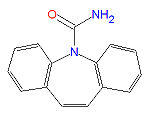Carbamazepine: Difference between revisions
Jump to navigation
Jump to search

imported>Robert Badgett (Added adverse effects and fixed external links.) |
mNo edit summary |
||
| (2 intermediate revisions by 2 users not shown) | |||
| Line 58: | Line 58: | ||
== References == | == References == | ||
<references/> | <references/>[[Category:Suggestion Bot Tag]] | ||
Latest revision as of 16:01, 24 July 2024
|
| |||||||
| carbamazepine | |||||||
| |||||||
| Uses: | anticonvulsant | ||||||
| Properties: | |||||||
| Hazards: | |||||||
| |||||||
Carbamazepine is an anticonvulsant drug used to treat epilepsy, grand mal seizures and psychomotor or focal seizures, neurologic pain, as from trigenimal neuralgia, psychiatric disorders including manic-depressive illness and dementia related aggression. Its three-dimensional structure and action is similar to that of phentoin despite being quite dissimilar chemically. It is also similar to the tricyclic antidepressant medications.[1]
Brand names
Adverse reactions
Toxic epidermal necrolysis (TEN) and Stevens-Johnson syndrome (SJS) may occur in patients with HLA-B*1502 allele who take carbamazepine.[2].
External links
The most up-to-date information about Carbamazepine and other drugs can be found at the following sites.
- Carbamazepine - FDA approved drug information (drug label) from DailyMed (U.S. National Library of Medicine).
- Carbamazepine - Drug information for consumers from MedlinePlus (U.S. National Library of Medicine).
- Carbamazepine - Detailed information from DrugBank.
References
- ↑ Drug Bank page for Carbamazepine.
- ↑ Anonymous. Table of Valid Genomic Biomarkers in the Context of Approved Drug Labels. U.S. Food and Drug Administration
